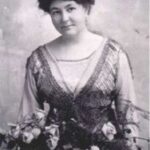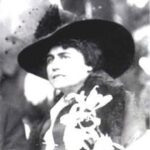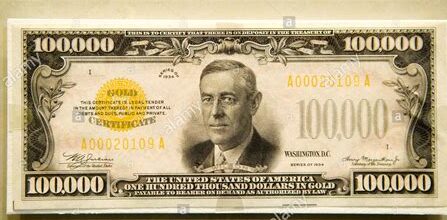Basic Facts:
Birth: December 28 1856 at Stauton, Virginia as Thomas Woodrow Wilson
Death: February 3, 1924 at Washington, D. C.
Married: (1) Ellen Louise Axson (1860-1914) on June 24, 1885; (2) Edith Bolling Galt (1872-1961) on December 18, 1915
Children: 3 with Ellen Axson: Margaret, Jessie, Eleanor
President: Two terms beginning March 4, 1913 and March 5, 1917
Family
 When she was eleven years old, Ellen Axson began studying art at the Rome Female College in Georgia, where she studied until training at the Rome (Georgia) Female College at the age of eleven. After her graduation in 1876, Ellen’s drawing titled School Scene was submitted to the Paris International Exposition where it won a bronze medal for excellence. She met Woodrow Wilson in April 1883 and they married in 1885.
When she was eleven years old, Ellen Axson began studying art at the Rome Female College in Georgia, where she studied until training at the Rome (Georgia) Female College at the age of eleven. After her graduation in 1876, Ellen’s drawing titled School Scene was submitted to the Paris International Exposition where it won a bronze medal for excellence. She met Woodrow Wilson in April 1883 and they married in 1885.
That same year, Bryn Mawr College in Pennsylvania offered Dr. Wilson a teaching position at an annual salary of $1,500. He and his bride lived near the campus, keeping her little brother with them.
Together, the Wilsons had three daughters. Insisting that her children must not be born as Yankees, Ellen went to stay with relatives in Gainesville, Georgia for Margaret’s birth in 1886 and Jessie’s in 1887. But Eleanor was born in Connecticut in 1889, while Wilson was teaching at Wesleyan University.
- Margaret Woodrow Wilson (1886–1944) – singer, businesswoman, Hindu nun. A recording of her singing “My Laddie” is available on You Tube.
In 1938 Margaret Wilson traveled to India, where she remained for the rest of her life. She became a member and devotee of the ashram and was given the new name ‘Nistha’, meaning “dedication” in Sanskrit. She and the scholar Joseph Campbell edited the English translation of the classical work on the Hindu mystic, Sri Ramakrishna, The Gospel of Sri Ramakrishna by Swami Nikhilananda, which was published in 1942. - Jessie Woodrow Wilson (1887–1933) – she worked three years at a settlement house in Philadelphia. She married Francis B. Sayre at the White House in 1913. Their November 25, 1913, wedding was the thirteenth White House wedding, and the first since Alice Roosevelt and Nicholas Longworth were wed in 1906. They settled at Cambridge, Massachusetts, when Sayre joined the faculty of Harvard Law School. Jessie was active in the League of Women Voters, the YWCA, and as secretary of the Massachusetts Democratic Committee. Sayre died at age 45 after undergoing abdominal surgery
- Eleanor Randolph Wilson (1889–1967), she married Secretary of the Treasury William Gibbs McAdoo at the White House on May 7, 1914. They had two daughters.
Ellen died of Bright’s disease at the White House on August 6, 1914. She was the third First Lady to die in office.
 Edith Bolling Galt was Wilson’s second wife. They married December 18, 1915.
Edith Bolling Galt was Wilson’s second wife. They married December 18, 1915.
In 1896 Edith Bolling married Norman Galt. In 1903, she bore a son who lived only for a few days. The difficult birth left her unable to have more children.
Galt died January 1908. Edith hired a manager to oversee his business, paid off his debts, and with the income left to her by her late husband, toured Europe.
As First Lady during World War I, Edith Bolling Wilson observed gasless Sundays, meatless Mondays, and wheatless Wednesdays to set an example for the federal rationing effort. Similarly, she set sheep to graze on the White House lawn rather than use manpower to mow it, and had their wool auctioned off for the benefit of the American Red Cross
Edith Wilson played an influential role in President Wilson’s administration following the severe stroke he suffered in October 1919. For the remainder of her husband’s presidency, she managed the office of the president, a role she later described as a “stewardship,” and determined which communications and matters of state were important enough to bring to the attention of the bedridden president.
On December 8, 1941, one day after Japan’s attack on Pearl Harbor, Franklin D. Roosevelt asked Congress to declare war, taking pains to draw a link with Wilson’s April 1917 declaration of war. Edith Bolling Wilson was present during Roosevelt’s address to Congress. Twenty years later, in 1961, Mrs. Wilson attended the inauguration of President John F. Kennedy.
Other
Wilson was 6′ 1.5″ tall
Wilson was 9 years old when the Civil War ended. His mother tended to wounded Confederate soldiers.
Wilson attended College of New Jersey (Now named Princeton), where he graduated 38th in his class of 167 students. He obtained his PhD in political science from Johns Hopkins University.
Wilson became president of Princeton in 1902, Governor of New Jersey in 1910 and president in 1913.
In adulthood he dropped his first name “Thomas” and was henceforth called “Woodrow”.
With the advent of automobiles imminent, Wilson became the last American president to arrive to his inauguration while being transported by horse-drawn carriage.
Wilson is considered one of the early “Progressive” presidents. “Woodrow Wilson, the very model of the modern Progressive, utterly rejected the Founders’ self-evident truths and unalienable rights. Wilson and the modern Progressives saw the Declaration and the Constitution as anachronisms that America needed to progress beyond.” American Thinker, Sept. 15, 2014.
Wilson had a history of health issues, but stress related to promoting the League of Nations led to a series of strokes in 1919. The partially incapacitated Wilson remained in office until 1921. Eventually, the 25th Amendment, ratified in 1967, allowed for constitutional measures to deal with temporary or permanent incapacity of the President in office.
Wilson won the Nobel Peace Prize in 1919 for his efforts to avert future world wars.
From National Interest.org – Why Wilson was America’s worst president”
His great flaw was his sanctimonious nature, more stark and distilled than that of any other president, even John Quincy Adams (who was no piker in the sanctimony department). He thought he always knew best, because he thought he knew more than anybody else.
He was against integration. When he was in office, he allowed all of his cabinet officials to expand segregation within their government departments to levels that hadn’t been seen since the Civil War. He believed that the minorities in America were trying to dominate the white majority and that they needed to be put into their place. He even supported the creation of a film that sponsored support for the Ku Klux Klan.
He advocated for a woman’s right to vote.
Wilson was the first president to routinely screen movies in the White House. Actor Douglas Fairbanks gifted him with a projector in 1918, allowing Wilson to enjoy movies with regularity. He sometimes watched up to five hours a day. While cruising the Atlantic following the Allied victory in World War I, Wilson set up the projector so troops could enjoy Charlie Chaplin films.
In 1918, with World War I raging, Wilson wanted to be a model for Americans in supporting troops. Allowing sheep to roam the grounds of the White House and eat grass cut down on the manpower needed to maintain the lawn, an example of rationing manpower; their wool was auctioned off and raised $52,823 for Red Cross relief efforts.
Wilson is the only U.S. President buried in Washington, D.C. The 28th President is in a sarcophagus at the Washington National Cathedral.
 His face is on the $100,000 dollar bill.
His face is on the $100,000 dollar bill.
Return to The Presidents main page.
Sources:
Internet Public Library
You Tube.com – President Wilson’s daughter sings…My Laddie by Margaret Woodrow Wilson 1917
You Tube.com- President Woodrow Wilson 2nd Inaugural Address – Hear and Read the Full Text
Constitution Center.org
Thought Co.com
Mental Floss.com
American Thinker, Sept. 15, 2014.
Greenman, Barbara. The Timeline History of U. S. Presidents and First Ladies. Thunder Bay Press, San Diego, California, 2009.
